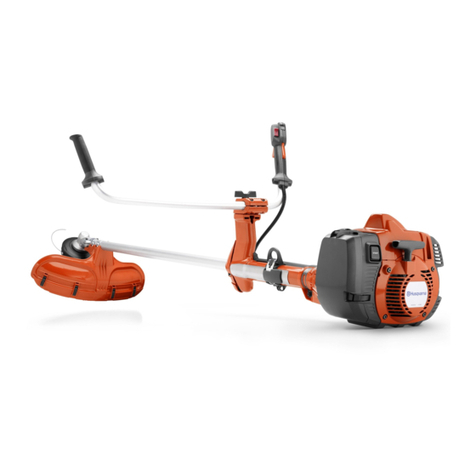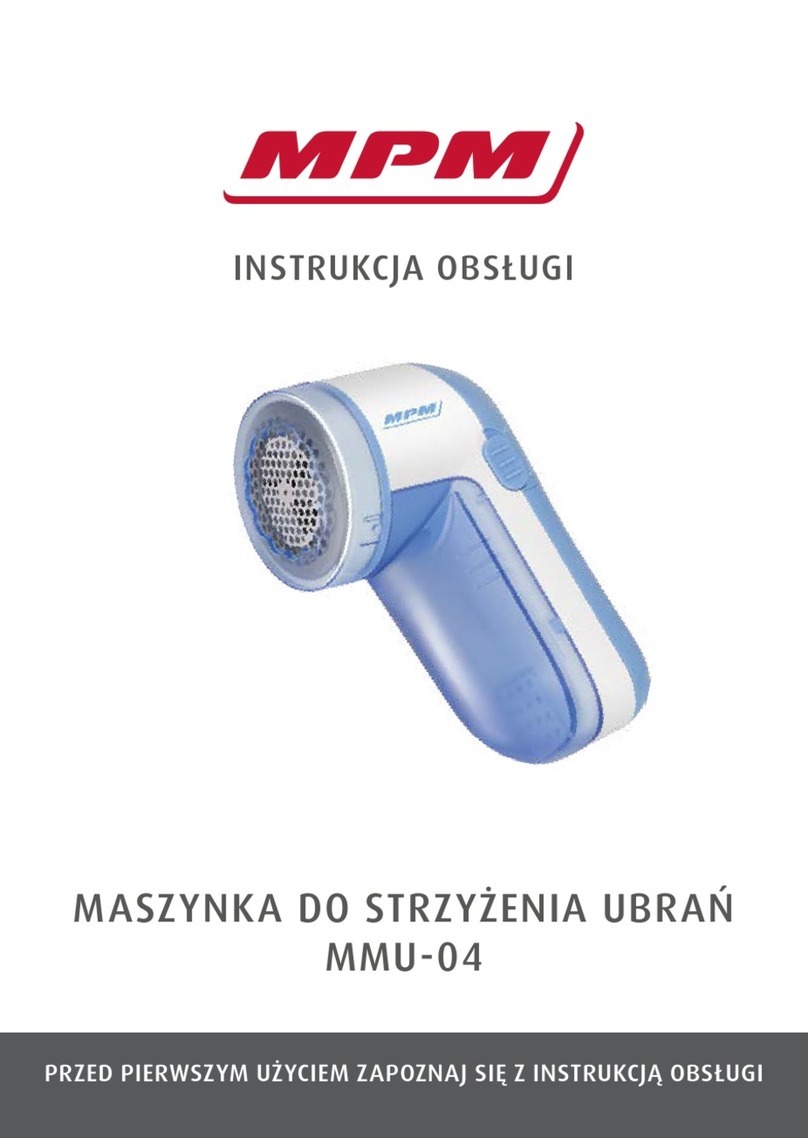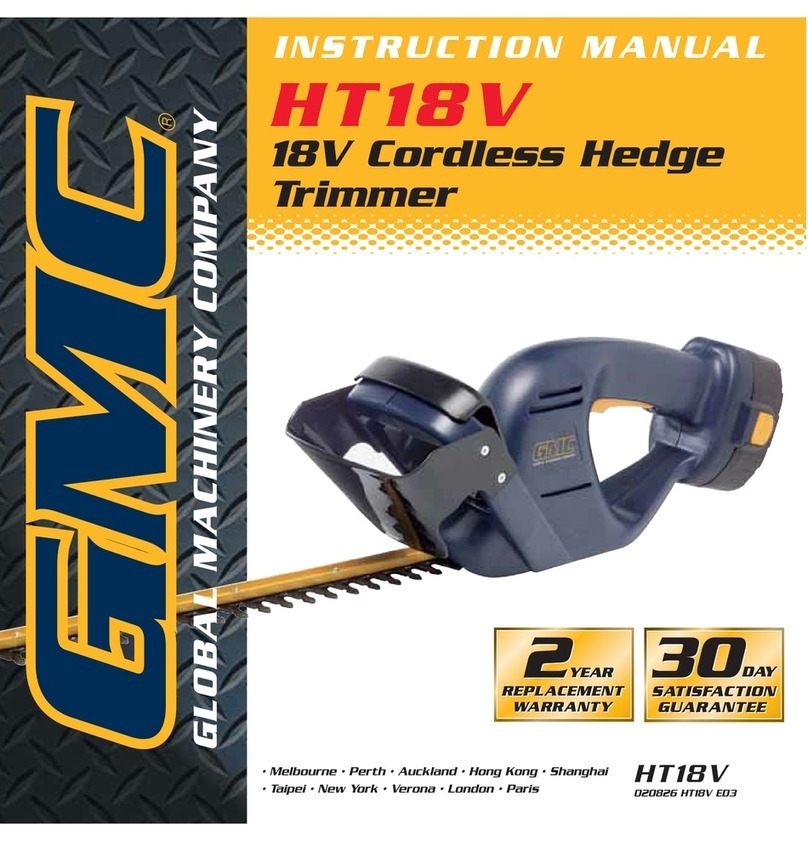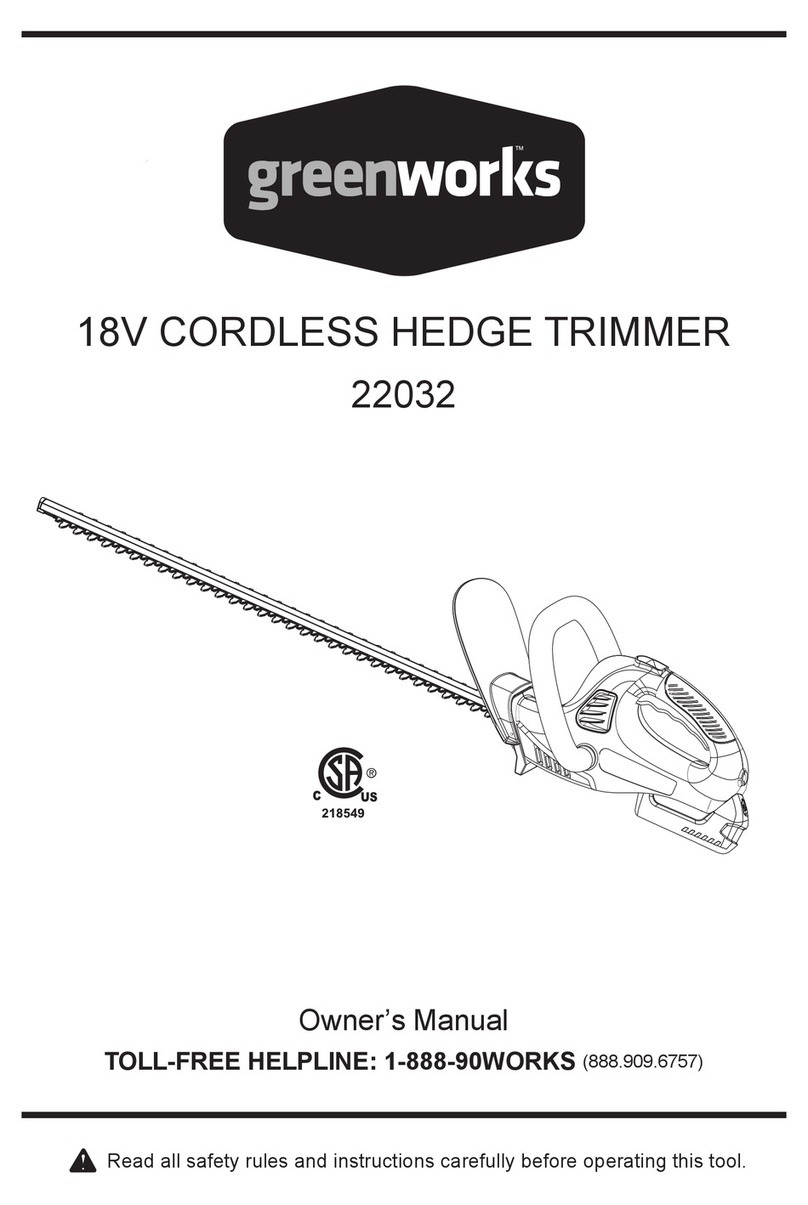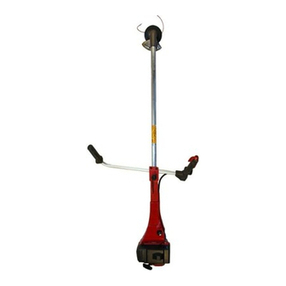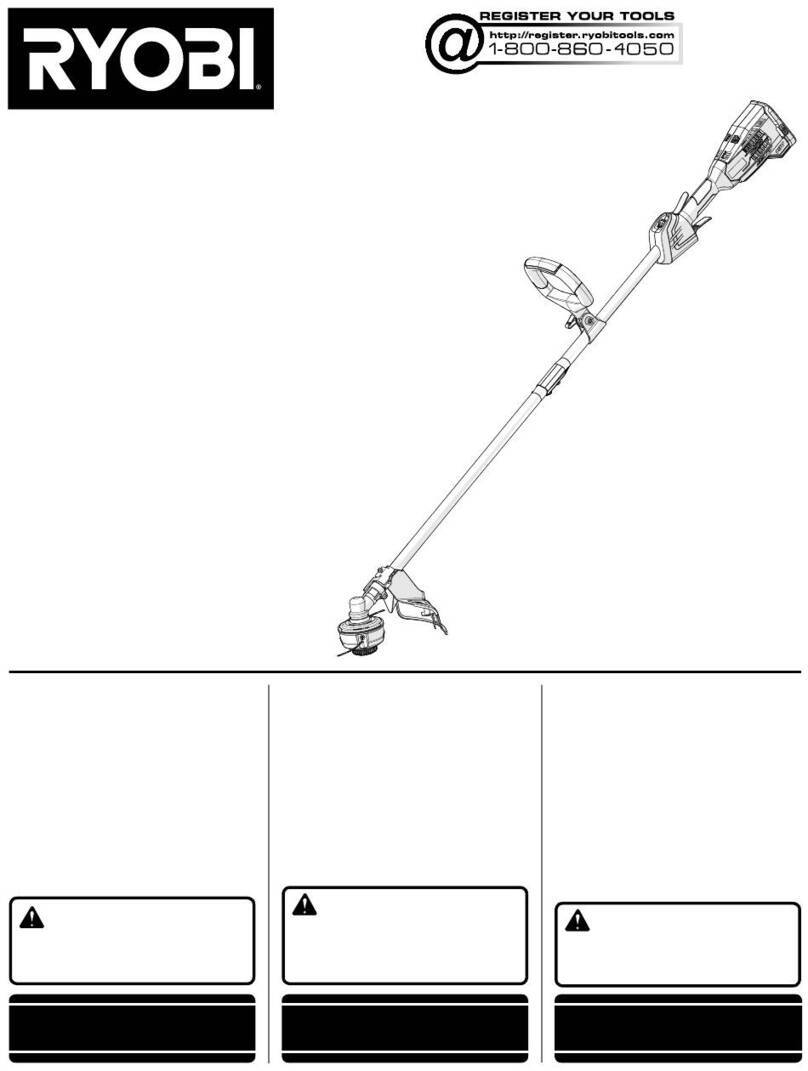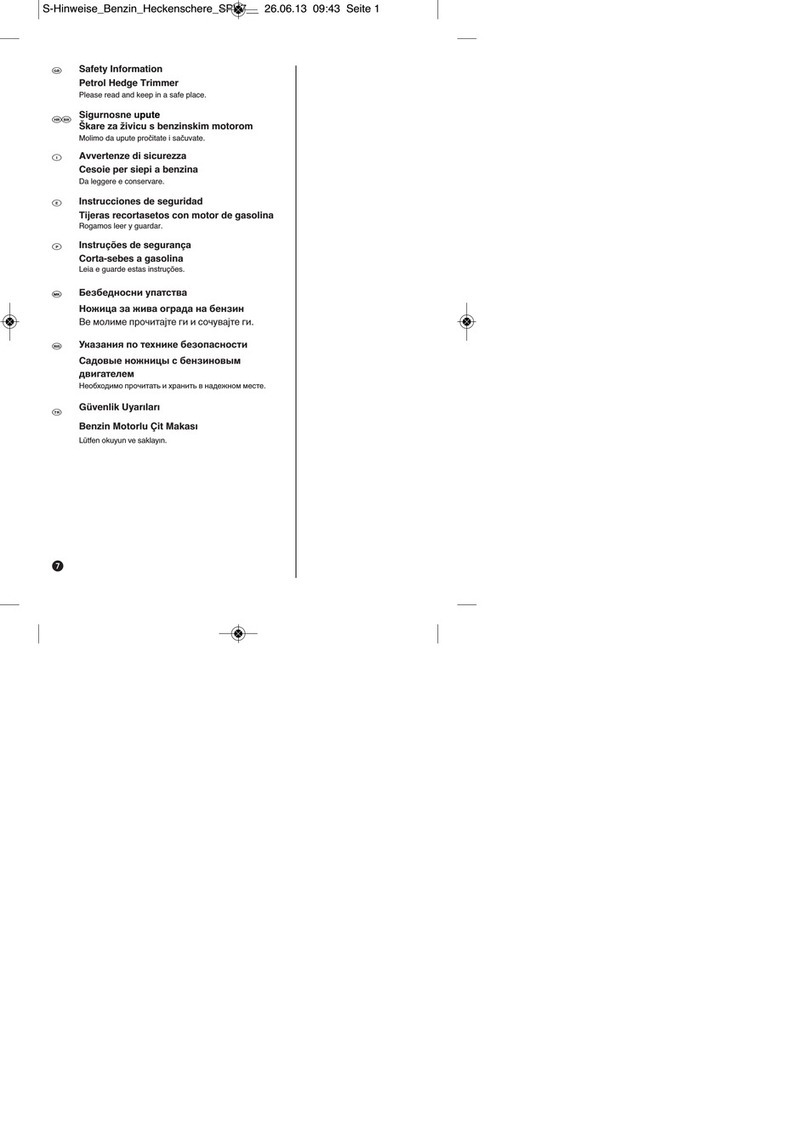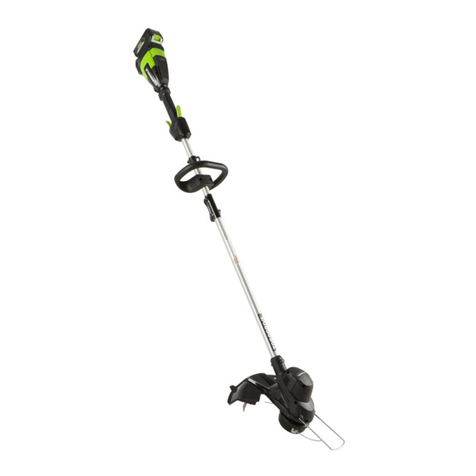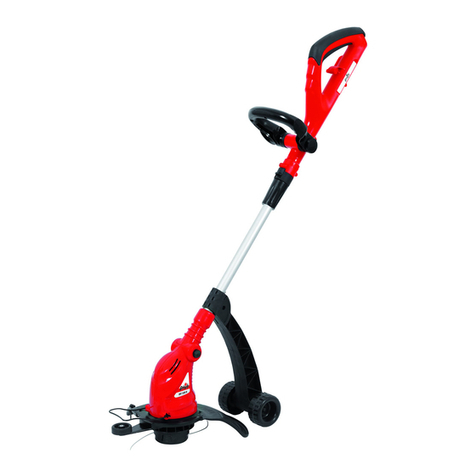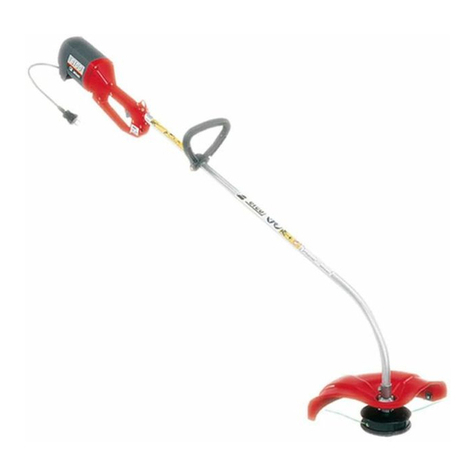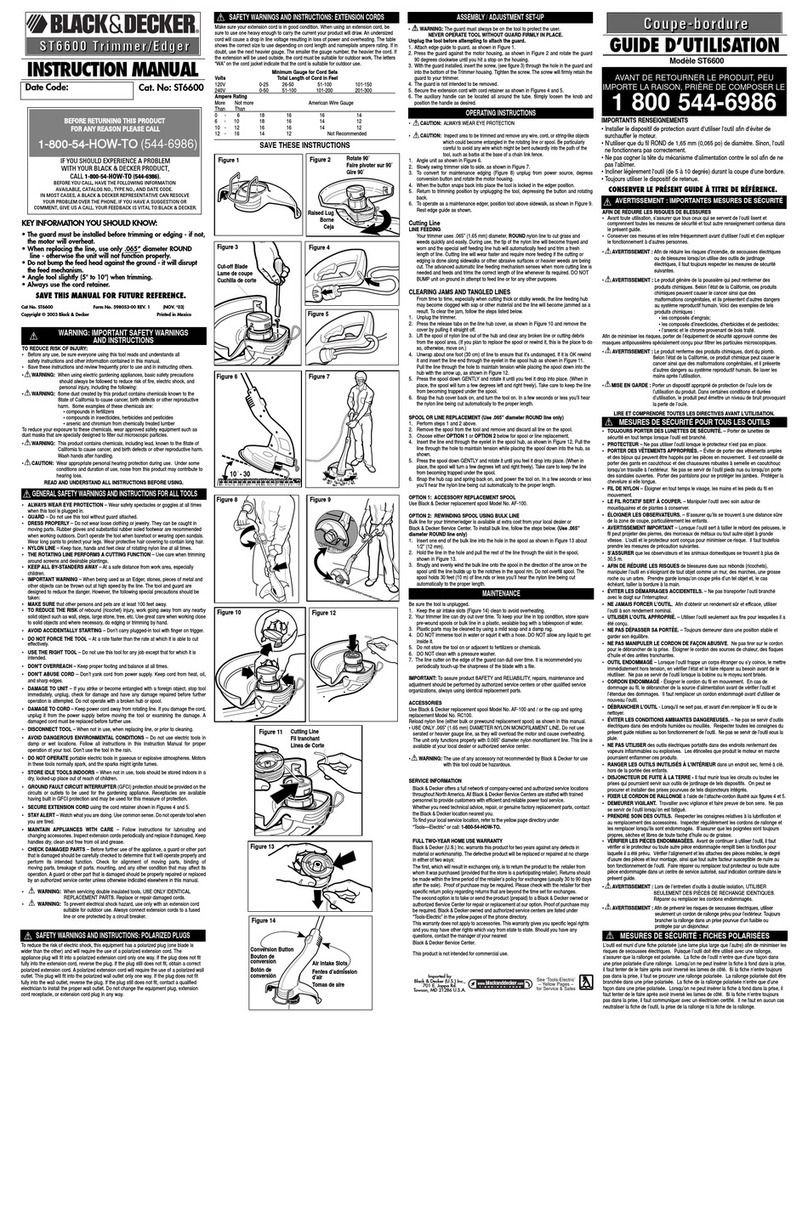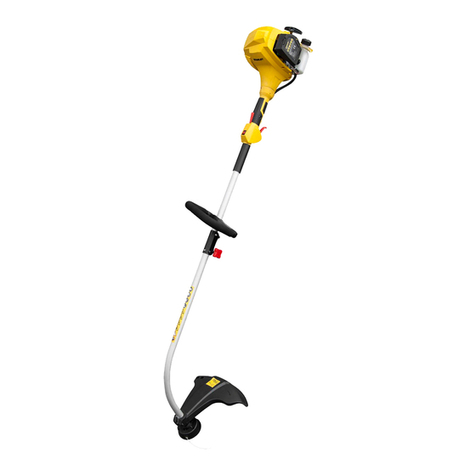Trueshopping SFHT00B2SA User manual

Lithium-Ion 40V Hedge Trimmer
MODEL NUMBER: SFHT00B2SA
OWNER’S MANUAL
Please read this manual carefully before using this tool.
Welcome from Trueshopping
Thank you for purchasing this tool from Trueshopping! This product has been carefully engineered and
manufactured to give you dependable and safe operation. Please read this manual thoroughly before
operating your new tool, as it contains the information you need to become familiar with its features and
obtain the performance that will bring you continued satisfaction for many years. Please keep this manual on
file for future reference.
SAFETY SYMBOL INFORMATION
WARNING: Read and understand this entire instruction
manual before attempting to assemble, install, operate or
maintain this product. Failure to comply with the instructions
may result in serious personal injury and/or property damage!
The following signal words are used to emphasize safety
warnings that must be followed when using this product:
DANGER: Indicates an imminently hazardous situation that,
if not avoided, WILL result in death or serious injury.
WARNING: Indicates a potentially hazardous situation that,
if not avoided, COULD result in death or serious injury.
CAUTION: Indicates a potentially hazardous situation that, if
not avoided, MAY result in minor or moderate injury.
NOTICE: Indicates important information, which if not
followed, MAY cause damage to equipment.

2
CONTENTS
SECTION PAGE
Safety Symbol Information ......................................................................1
Specifications ...........................................................................................2
General Safety Rules ................................................................................2
Power Tool Safety Use and Care ..............................................................3
Personal Safety ........................................................................................3
Hedge Trimmer Safety .............................................................................4
Charger Care and Use ..............................................................................4
Battery Care and Use ..............................................................................5
Functions/Features Description ..............................................................6
Battery Information & Safety ..................................................................7
Hedge Trimmer Operation ......................................................................8
Maintenance ...........................................................................................8
Troubleshooting ......................................................................................8
Warranty .................................................................................................9
GENERAL SAFETY RULES - FOR ALL BATTERY
OPERATED TOOLS
Read the ENTIRE manual before set up or use of this product.
Work Area Safety
•Keep work area clean and well lit. Cluttered and dark
areas invite accidents.
•Do not operate power tools in explosive atmospheres,
such as in the presence of flammable liquids, gases or
dust. Power tools create sparks which may ignite the
dust or fumes.
•Keep children and bystanders away from the work area
while operating a power tool. Distractions can cause
you to lose focus and cause an accidental injury.
(The following applies only to tools with a separate battery pack)
CAUTION: Burn Hazard: A battery operated tool with integral
batteries or a separate battery pack must be recharged only
with the specified charger for the battery. A charger that may
be suitable for one type of battery may create a risk of fire
when used with another battery. Only use the appropriate
Trueshopping charger for this tool.
WARNING: Shock Hazard. Do not allow your charger to be
exposed to rain or any other wet conditions that can allow
liquids to get inside of it.
CAUTION: Burn Hazard: Your tool was designed to be used
only with the batteries that were supplied by the manufacturer.
Using any other battery packs increases the risk of creating a fire
and/or causing bodily injury. You may also damage the tool or
battery. Only use the appropriate Trueshopping batteries for
this tool.
•Make sure that you always use the proper voltage
indicated on the charger. Using a higher voltage power
source could damage the charger. (120v is approved to
use with this tool).
•If you notice an electrical or mechanical malfunction,
immediately unplug the charger from the power
source.
CAUTION: Be careful not to cut, drill or drive into areas where
electrical wires may be contacted.
•Do not touch the contacts in the charger when it is
plugged into the power source.
•Do not expose the tool, charger or battery to rain or
other wet environments.
•Never charge the batteries outdoors where they can be
exposed to rain or other wet environments.
WARNING: Burn Hazard; Battery liquids may be flammable
when exposed to spark or flames and may explode. Do not burn
a battery for any reason
•When damaged, and under extreme usage and
temperature conditions, batteries may start to leak if
liquid comes into contact with the skin, wash quickly
with soap and water - if liquid gets into the eyes, flush
eyes with clean water for a minimum of 10 minutes and
seek medical attention immediately.
•When a battery is not in the tool or charger, it should
be kept away from metal objects such as nails, screws,
keys etc. to prevent short-circuit.
•Do not use the charger when damaged. Doing so may
cause a personal shock or create a fire.
•Do not use a battery when it is damaged; it should be
replaced immediately.
SPECIFICATIONS
Li-ion Cordless Hedge Trimmer
Bar Length: 16 inches
Maximum Cutting Capacity: 5/8"inch
Battery Pack
Nominal Battery Charge: 40V (DC) max
Battery Pack: Lithium Ion 4.0Ah
Charging time: Approx. 2.5 Hours
Charger
Input: 120V (AC) / 60Hz
Output: 42V (DC)
Specifications are subject to change without notice.

3
CAUTION: Do not disassemble your charger or battery at
any time.
CAUTION: Do not attempt to recharge non-rechargeable
batteries with the charger
•When using your tool continuously, the batteries in
your battery pack can become hot. You should let a
hot battery pack cool down for approximately 30
minutes before attempting to recharge it.
WARNING: Fire Hazard. Do not store or carry any battery so
that metal objects can contact exposed battery terminals. For
example, do not place batteries in aprons, pockets, tool boxes,
product kit boxes, drawers, etc., with loose nails, screws, keys,
etc. Transporting batteries can possibly cause fires if the battery
terminals inadvertently come in contact with conductive
materials such as keys, coins, hand tools and the like. The US
Department of Transportation Hazardous Material Regulations
(HMR) actually prohibit transporting batteries in commerce or
on airplanes (i.e., packed in suitcases and carry-on luggage)
UNLESS they are properly protected from short circuits. So when
transporting individual batteries, make sure that the battery
terminals are protected and well insulated from materials that
could contact them and cause a short circuit.
POWER TOOL SAFETY USE AND CARE
WARNING: Use only the accessories that are recommended
for this tool. Using accessories that are not recommended, or
designed for use with this tool, could be hazardous.
•Do not apply extra force to the tool to do the job. Use
the correct tool for your application. The correct tool
will do the job better and safer at the rate for which it
is designed.
•Do not use a tool with a defective switch. A tool that
cannot be controlled with the switch is dangerous and
must be repaired.
•Store idle tools out of reach of children and other
untrained persons. Tools are dangerous in the hands
of untrained users.
•Maintain tools with care. Keep cutting tools sharp and
clean. Properly maintained tools with sharp cutting
edge are less likely to bind and are easier to control.
•Check for misalignment or binding of moving parts,
breakage of parts, and any other condition that may
affect the tool’s operation. If damaged, have the tool
serviced before using it. Many accidents are caused by
poorly maintained tool.
PERSONAL SAFETY
•Stay focused while using your power tool. Never operate
any power tool while you are overly tired or under the
influence of drugs, alcohol or mind altering medications.
Losing your focus for just a short moment, while operating
any power tool could cause a serious injury.
•Do not wear loose clothing or jewellery while operating any
power tool. Properly contain long hair to avoid personal
injury. Keep your clothing, and gloves away from moving
parts. Loose clothes, jewellery, or long hair can be caught in
moving parts and may cause a serious injury.
•Avoid accidental starting of your tool. Be sure the power
switch is in the locked or off position before inserting a
battery pack. Carrying tools with your finger on the trigger
switch can also cause an accident.
•Remove adjustment keys and/or wrenches from your tool
before turning it on. A wrench or a key that is left attached

4
to any part of the tool increases the risk of causing an
injury.
•Keep hands clear of all moving parts while in operation.
•Make sure you have proper footing and balance at all times
while operating any power tool. Proper footing and balance
allows you to have better control of the tool in unexpected
hazardous situations.
•Use safety equipment. Always wear eye protection, a dust
mask, non-skid safety shoes, or hard hat when needed,
while operating your power tool. Doing so will greatly
reduce the risk of an unnecessary injury.
•Hold the power tool by the insulated grip surface when
performing an operation where it may contact hidden
wiring. Contact with a “live” wire will also make exposed
metal parts of the tool “live” and can shock the operator.
•Allow the power tool accessories (bits, blades etc) to cool
before touching them. They can become extremely hot
during use and can burn your skin.
•Always wear protective safety glasses when operating
power tools. Wear a face mask when the working
environment is dusty.
HEDGE TRIMMER SAFETY
•Do not use the trimmer in the rain.
•Keep hands and fingers well away from the blade.
•Wear work gloves, eye protection, solid shoes and
trousers when using this hedge trimmer.
•Always grasp both handles when operating the unit.
•Disconnect the trimmer from the mains supply when you
have finished work, before cleaning or if you have been
interrupted.
•This trimmer has been designed to cut soft, new growth
and should not be used on branches, hard wood or other
forms of cutting.
•Do not attempt to free a jammed blade before first
switching off the machine and removing the battery
pack.
•If you are interrupted when operating the trimmer,
complete the process and switch off before looking up.
•Never allow untrained users or children to use the
trimmer.
Wear goggles. Wear ear defenders. Wear a breathing
mask.
CHARGER CARE, SAFETY & USE
•Only use the battery charger this is specifically
designed for the tool.
•The charger is double insulated for additional electrical
safety.
•The Charger is for indoor use only.
•If the charger supply cord is damaged, do not use it. It must
be replaced by the manufacturer, its service agent or
similarly qualified persons in order to avoid a hazard.
NOTE: Before using the tool, read the instruction carefully.
•This tool is equipped with a 2.5 hour quick charger. It also
was designed with the Auto-Shut-off safety feature. This
feature stops the battery charging process after the battery
is fully charged. This prevents over heating of both the
battery and charger and helps to prevent an electrical fire.
WARNING: DO NOT INTENTIONALLY LEAVE THE BATTERY IN
THE CHARGER FOR LONG PERIODS OF TIME BECAUSE OF THE
AUTO SHUT-OFF FEATURE. IF THE CHARGER IS DAMAGED IN
UNKNOWN WAYS, IT COULD STILL CAUSE OVERHEATING AND
A FIRE.
IF before using your hedge trimmer your battery pack is
UNCHARGED from the factory. You must fully charge it once
before use.
WARNING: The charger is specifically designed to be used
only with the batteries that are fitted with this tool. Do not
attempt to charge any other batteries with this charger. Never
insert or allow any metallic objects to come into contact with

5
the charger connections. This could damage the
charger and could cause and electrical failure and a
hazard could occur.
WARNING: In a warm or hot environment and
after heavy use, the battery pack may become too
hot. Allow it to cool down for at least 30 minutes
before recharging. If you do not wait for the battery
to cool off when it is hot before recharging it, the
charger may not turn off when the charging cycle is completed
and both the charger and battery will overheat. This will
damage the battery and charger and may cause an electrical
fire.
NOTE: When the battery is charged for the first time and after
prolonged storage, the battery will only accept approximately
60% charge. However, after several charge and discharge cycles
the battery will accept 100% charge.
BATTERY CARE, SAFETY & USE
CAUTION: Recharge your batteries only with the charger
specified by the manufacturer. Charging a battery with a charger
that is designed to be used with only one type of battery pack
will increase the risk of an electrical fire. This could also damage
the battery or charger.
CAUTION: Liquid leaking from a battery pack may cause
irritation or burns. Under certain abusive or accidental
conditions, a battery pack can be damaged, and liquid may
cause the battery to leak. If this occurs, avoid contact. If contact
accidentally occurs, immediately wash with water and soap. If
liquid contacts your eyes, flush out your eyes with water and
consult your doctor for help.
WARNING: DO NOT INTENTIONALLY LEAVE THE BATTERY IN
THE CHARGER FOR LONG PERIODS OF TIME BECAUSE OF THE
AUTO SHUT-OFF FEATURE. IF THE CHARGER IS DAMAGED IN ANY
WAY, IT COULD STILL CAUSE OVERHEATING AND A FIRE
a) Only use battery packs that are specifically designed for your
power tool. Using the wrong battery pack may create a risk
of injury and fire and could damage your tool.
b) Always remove the battery pack from the charger
immediately after re-charging is completed.
c) Do not charge a damaged battery pack.
d) Do not charge non-rechargeable batteries.
e) Lithium-ion and lithium polymer cells and battery packs may
get hot, explode or ignite and cause serious injury if exposed
to abusive conditions.
f) Do not connect the positive terminal and negative terminal
of the battery to each other with any metal object (such as
wire).
g) When the battery pack is not in use, keep it away from metal
objects, like paper clips, coins, keys, nails, screws or other
small metal objects that can make a connection with the
battery terminals to. Metal objects making contact with the
battery terminals may cause burns or a fire.
h) Do not pierce the battery with nails, strike the battery with a
hammer, step on the battery or otherwise subject it to
strong impacts or shocks.
i) Do not attempt to solder the battery terminals.
j) Do not expose the battery to water or allow it to get wet.
k) Do not disassemble or modify the battery. The battery
contains safety and protection devices, which, if damaged,
may cause the battery to generate heat, explode or ignite.
The protection circuit module provided with the battery
pack is not to be used as a substitute for a shut-off switch.
l) Do not place the battery in or near a fire, on stoves or other
high temperature locations. Do not place the battery in
direct sunlight or use or store the battery inside cars in hot
weather. Heating the battery can damage the safety
circuitry, which can cause additional heating, rupture or
ignite the battery. Using the battery in this manner may also
result in a loss of performance and a shortened life.
m) Do not place the battery in microwave ovens, high
temperature containers or on induction cookware.
n) If you intend to store a battery for a short period of time
without use then store it at room temperature between
(66°to 77°F). When storing the battery for very long periods,
recharge it once per year to prevent an over discharge.

6
o) Always charge the battery in a temperature range of (32° to
113°F) and discharge in a temperature range of (32° to
140°F).
p) The battery pack and charger will be warm during charging,
this is normal.
q) Do not continue charging the battery if it does not recharge
within the specified charging time. Doing so may cause the
battery to become hot, explode or ignite. The temperature
range over which the battery can be charged is 32°F to
113°F. Charging the battery at temperature outside this
range may cause severe damage to the battery or reduce the
battery life expectancy.
FUNCTIONS/FEATURES DESCRIPTION
Battery Charging
IMPORTANT Before plugging in the power supply from the
charger (7) always ensure that the plug is switched off at the
mains power.
IMPORTANT The battery will be fully charged after approx. 2.5
hours: remove it from the charger after this time. Do not leave a
battery charging for longer than 24 hours
Component list
1
.
Rear Handle Trigger Switch
2
.
Front Handle Bar Switch
3
.
Front Handle
.
4
Lock Off Button
.
5
Guard
.
6
Blade
.
7
Battery Charger (not included)
.
8
Battery
(not
included)
Connecting and Removing Battery
To remove the battery pack from the tool firmly press the battery release
button at the back of the battery pack and slide the battery pack backward,
and then pull or lift the battery out of the tool.
To install the battery pack into the tool, align the rails of the battery pack
with the rails in the tool and push the battery into the housing. To connect
the battery, slide the battery pack fully forward.
1
3
5
6
7
8
r) When the battery is worn out, insulate the terminals with
adhesive tape or similar materials before disposal.
s) Do not dispose of a battery in a fire, or with household waste.
Return exhausted battery to your local recycling centre.
t) Immediately discontinue use of the battery if, while using,
charging or storing the battery, the battery emits an unusual
smell, feels hot, changes colour or shape, or appears abnormal in
any other way.
2
4
IMPORTANT The battery will be fully charged after
approx. 2.5 hours: remove it from the charger after this
time. Do not leave a battery charging for longer than 24
hours.
1. Connect the charger (7) to a mains
power outlet (120Vac). The Green light
will glow on POWER.
2. Insert the battery (8) into the charger.
3. The red indicator will glow on CHARGER
indicating power on charge
4. When the battery is fully charged, the
green light on CHARGER will glow.
Note: You do not have to wait for a full charge
of the battery to use it on the tool. The battery
may be used on the tool as long as there is some
charge in the battery.

7
CAUTION: If using the battery in a semi-charged state after
a period of charging be sure to remove the battery from the
charger. DO NOT use the Battery on the tool if it is connected
to the charger.
1. Remove the battery from the charger and the
charger from the mains power.
BATTERY INFORMATION & SAFETY
To obtain the best life for the battery
Never allow the tool to completely drain the battery and come
to a complete stand still before recharging. The battery should
be placed on charge whenever the battery is noticeably
running down or the tool no longer performs a task it
previously performed. For storage, charge between 50 and
75%. Avoid allowing loose items like screws or nails etc. to be
stored with battery packs as these or similar items can short
battery packs and cause a fire or explosion. Always unplug the
charger when not in use and store in a dry secure place. Avoid
charging or storing your battery in temperatures below 0ºC and
above 40ºC.
Battery Overload
The battery is fitted with an overload protection system. If the
tool is excessively forced, or the task being performed is too
great for the tool, the battery will automatically go into an
overload mode. When the tool goes into overload, the tool will
automatically and suddenly STOP. To reset the overload, simply
release the trigger. When the trigger is pressed again, the tool
will restart. Resume work after the overload has been reset but
reduce the size of the cut or reduce the force on the tool to
make the cut.
CAUTION. Do not continue to overload the tool and constantly
reset the overload. Doing this will cause the battery cells to
overheat.
HEDGE TRIMMER OPERATION
Safety features
1. The cutting blade is supplied with a sheath
type cover. Keep the cover on the blades
whenever the tool is not being used. 2. When
the hedge trimmer is not being used it is
suggested to remove the battery pack to
prevent unauthorised use of the tool. 3. The
rear handle trigger switch (1) and front handle
bar switch (2) must be operated together to start the motor. This
ensures that both hands are used to control the trimmer. 4. If
either of the two switches is released, the tool is designed to stop
Temperature cut out
If the tool is constantly overloaded, or the tool is used constantly
at maximum rating in high ambient conditions, the battery cells
may over heat causing the battery pack to shut down. The tool
will not restart until the battery pack has cooled. If this occurs,
you will need to immediately stop working and allow the battery
cells to cool down. To reduce the temperature of the cells,
remove the battery pack from the tool and place the battery
pack in a free air environment, out of direct sunlight or any other
heat source. DO NOT force cool the pack in any way. Do not
place in refrigerators or freezers. When the battery pack has
cooled down it can again be used to operate the tool, as long as
the load or the conditions causing the original excessive
temperature has been corrected.
Low voltage cut out
The battery pack used on this tool is fitted with a low voltage cut
out feature within the circuitry. The low voltage cut out feature
operates when the voltage drops below a pre-set value. This
feature automatically stops the tool from operating (similar to
that of the over load condition). When this condition occurs, you
will need to either insert another battery into the tool or
recharge the existing battery. The low voltage cut out feature
has been added to maximise the tool’s life. When this occurs,
recharge the battery pack by following the battery charging
section in this manual. Note: Attempting to restart the tool
without either recharging the battery or installing another
battery (with charge) will lead to the tool restarting and then
stopping again, after only a few seconds of operation.
rapidly.
Shaping
1. Trim a hedge so that it is
wider at the bottom than
the top. 2. This improves
light penetration and
promotes healthy growth. 3.
Narrow the hedge
approximately 1/2 in. for
every 3-1/2 ft. in height. 4. A
bush can be round or
column shaped.

8
Switching on and off
1. To switch on, press both the trigger
switch (1) and the bar switch (2) at the
same time. 2. The bar switch (2) can be
activated from 3 positions; to the left
of the handle, to the right of the
handle, or to the top of the handle. 3.
To switch off, release either switch.
Safety points during operation.
• Wear eye protection when using this tool.
• Always use two hands to hold the tool. One on the rear handle
and one on the front loop handle.
• Always ensure good balance. Both feet should be firmly on the
ground.
WARNING. Do not let the blade come into contact with
fencing wire or any other object that could damage it.
MAINTENANCE
TROUBLESHOOTING AND FAQ
Should you encounter any problems when using your cordless
tool, check the following list.
Cutting
1. Assume a secure position, using
two hands to hold the trimmer
and switch on. 2. Trim both sides
of the hedge, starting at the
bottom. This prevents cuttings
falling into the area yet to be cut.
3. Pass the blade lightly through
the surface of the hedge. Do not
attempt to cut too deep. 4. Trim
the top of the hedge. 5. For older
hedges that require cutting back
substantially, use pruning shears
to cut the thicker branches and
then finish the job with the hedge
trimmer.
Pruning
Your hedge trimmer is versatile. It can also be used for
trimming back new growth from small shrubs onto the
driveway or into the garden
1. Regularly check that all the fixing screws are tight.
They may vibrate loose over time.
2. Store the tool, instruction manual and accessories in
a secure, dry place. In this way you will always have
all the information and parts ready to hand.
3. Keep the tool’s air vents unclogged and clean at all
times.
4. Remove dust and dirt regularly. Cleaning is best
done with compressed air or a rag.
5. Never use caustic agents to clean plastic parts.
6. Remove battery from tool during storage.
7. Replace blade cover when the tool is not being
used.
CAUTION. Do not use cleaning agents to clean the plastic parts
of the tool. A mild detergent on a damp cloth is recommended.
Water must never come into contact with the tool.
Blade maintenance
Wear gloves when handing or cleaning the cutting blade. Always
clean the cutting blade after operation and lubricate with
protective spray. During longer cutting jobs, we recommend
periodically lubricating the cutting blade with protective spray.
Visually check the condition of the cutting edges of the cutting
blade. Check tightness of blade bolts. Ensure that the blade is
covered with the blade protection supplied.
Lubrication
WARNING. Switch off and remove the battery before carrying
out any maintenance on the tool.
After each use, clean the blades and lightly lubricate with general
purpose oil or spray lubricant.
Should you encounter any problems when using your cordless tool, check the following list.

9
1. Battery Pack Leaks
A small amount of leakage may occur under extreme
temperatures or after heavy use. Immediately wash any
leakage from hands, skin or clothes with soap and water.
2. The Battery Pack Gets Warm During Use
The power-draw from the battery generates heat. This is
increased as the energy draw increases. You will not damage the
battery pack and the generated heat is normal. If the battery
does get hot. Should you desire to cool it down, simply allow the
tool to cool off prior to continuing your work.
3. The Battery Pack Gets Warm When Charging
This is normal; it is a result from the stepping down of the
chemical reactions inside the batteries during the charging
process.
THE CHARGER WILL GET WARM DURING CHARGING - this is
normal.
4. Battery Pack Overload and Low-Voltage Protection
•When the battery voltage is drained under normal
operation, it will cease to operate and will need to be charged.
•When the maximum allowable battery voltage is
exceeded during charging, the overload protection is activated to
protect the battery and charger against overheating.
6. Hot Battery Pack Protection
The normal charging temperature is between 0°F and 113°F.
When the battery pack is too hot, it automatically starts a HOT
battery pack delay, and suspends charging until it has reached
the correct temperature. The charging process will then
automatically begin. When the battery pack is over 140°F during
operation, the tool stops working automatically. Allow the tool
to cool down for re-operation.
No power
1. Check the battery if it
is charged or not.
2. Any of the parts are
defective, such as On/Off
switch / motor etc. (please
contact service agent).
3. Check both switches (1 &
2) are being pressed at the
same time.
The hedge trimmer operates
1. Any of the two handle
intermittently
switches are defective
(please contact service
agent).
2. Battery is nearly
empty.
3. Internal loose
electrical connection.
4. On/Off switch defective
(please contact service
agent).
Motor runs but blades remain
stationary
1. Internal fault (please
contact service agent).
The blade is not working
1. Cutting blade blunt
(have blade sharpened).
2. Cutting blade has
dents (have blade
overhauled).
3. Too much friction, due to
lack of lubricant
(apply lubricant spray).
WARRANTY
Trueshopping offers a Two-Year Limited Warranty from the date of purchase on this product when serviced regularly, to be free from defects in
materials and workmanship under normal use and service. If during the first 30 days of purchase your tool is found to be defective, you can call
customer service to receive a free replacement. This warranty applies only to the original purchaser of this tool. You must provide a copy of your
original sales receipt before a replacement can be granted.
If after the first 30 days of your purchase the product is found to be defective, you can call customer service for assistance. At their sole
discretion, they will determine whether they will repair or replace the needed part or parts for the tool or offer a free replacement. This warranty
does not apply to accessories that were included with the tool. It only applies to the tool and it’s components (i.e. charger and batteries).
NOTE: Trueshopping will not pay for or reimburse any fees for parts or labour services performed to fix or service this tool by an unauthorized
service centre or persons.
NOTE: Do not return this product for any reason before calling our Customer Service number 0333 320 7794.

10
Akku-Heckenschere 36V Li - Ion 4,0 AH
MODELL NUMMER: SFHT00B2SA
GEBRAUCHSANWEISUNG

11
Was bedeuten die verwendeten Symbole?
In der Gebrauchsanweisung
Gefahrenhinweise und Hinweise sind in der Gebrauchsanweisung deutlich gekennzeichnet. Es werden folgende Symbole verwendet:
Diese Symbole kennzeichnen die benötigte persönliche Schutzausrüstung.
Am Gerät
Symbole, die sich an Ihrem Gerät befinden, dürfen nicht entfernt oder abgedeckt werden. Nicht mehr lesbare Hinweise am Gerät müssen
umgehend ersetzt werden.
Gefahr!
Art und Quelle der Gefahr!
Bei Missachtung des Gefahrenhinweises entsteht eine Gefahr für Leib und Leben.
Achtung!
Art und Quelle der Gefahr!
Dieser Gefahrenhinweis warnt vor Geräte-, Umwelt- oder anderen Sachschäden.
Hinweis:
Dieses Symbol kennzeichnet Informationen, die zum besseren Verständnis der Abläu-
fe gegeben werden.
Achtung!
Diese Symbole kennzeichnen die benötigte persönliche
Schutzausrüstung.
Vorsicht beim Umgang mit dem Gerät! Alle Sicherheitshinweise aus der Gebrauchs-

12
Zu Ihrer Sicherheit
Allgemeine Sicherheitshinweise für Elektrowerkzeuge
Lesen Sie alle Sicherheitshinweise und Anweisungen!
Versäumnisse bei der Einhaltung der Sicherheitshinweise und Anweisungen können
Gefahr! elektrischen Schlag, Brand und/oder schwere Verletzungen verursachen.
Bewahren Sie alle Sicherheitshinweise und Anweisungen für die Zukunft auf.
Der in den Sicherheitshinweisen verwendete Begriff "Elektrowerkzeug" bezieht sich
Gefahr! auf netzbetriebene Elektrowerkzeuge (mit Netzkabel) und auf akkubetriebene Elektrowerkzeuge
(ohne Netzkabel).
Arbeitsplatzsicherheit
•Halten Sie Ihren Arbeitsbereich sauber und gut beleuchtet.
Unordnung oder unbeleuchtete Arbeitsbereiche können zu Unfällen führen.
•Arbeiten Sie mit dem Elektrowerkzeug nicht in explosionsgefährdeter Umgebung, in der sich brennbare Flüssigkeiten, Gase oder Stäube
befinden.
Elektrowerkzeuge erzeugen Funken, die den Staub oder die Dämpfe entzünden können.
•Halten Sie Kinder und andere Personen während der Benutzung des Elektrowerkzeugs fern.
Bei Ablenkung können Sie die Kontrolle über das Gerät verlieren.
Elektrische Sicherheit
•Vermeiden Sie Körperkontakt mit geerdeten Oberflächen, wie von Rohren, Heizungen, Herden und Kühlschränken.
Es besteht ein erhöhtes Risiko durch elektrischen Schlag, wenn Ihr Körper geerdet ist.
•Halten Sie Elektrowerkzeuge von Regen oder Nässe fern.
Das Eindringen von Wasser in ein Elektrogerät erhöht das Risiko eines elektrischen Schlages.
Sicherheit von Personen
•Seien Sie aufmerksam, achten Sie darauf, was Sie tun, und gehen Sie mit Vernunft an die Arbeit mit einem Elektrowerkzeug. Benutzen Sie
kein Elektrowerkzeug, wenn Sie müde sind oder unter dem Einfluss von Drogen, Alkohol oder Medikamenten stehen.
Ein Moment der Unachtsamkeit beim Gebrauch des Elektrowerkzeugs kann zu ernsthafte Verletzungen führen.
•Tragen Sie persönliche Schutzausrüstung und immer eine Schutzbrille.
Das Tragen persönlicher Schutzausrüstung, wie Staubmaske, rutschfeste Sicherheitsschuhe, Schutzhelm oder Gehörschutz, je nach Art und
Einsatz des Elektrowerkzeuges, verringert das Risiko von Verletzungen.
•Vermeiden Sie eine unbeabsichtigte Inbetriebnahme. Vergewissern Sie sich, dass das Elektrowerkzeug ausgeschaltet ist, bevor Sie es an die
Stromversorgung und/oder den Akku anschließen, es aufnehmen oder tragen.
Wenn Sie beim Tragen des Elektrowerkzeuges den Finger am Schalter haben oder das Gerät eingeschaltet an die Stromversorgung anschließen,
kann dies zu Unfällen führen.
•Entfernen Sie Einstellwerkzeuge oder Schraubenschlüssel, bevor Sie das Elektrowerkzeug einschalten.
Ein Werkzeug oder Schlüssel, der sich in einem drehenden Geräteteil befindet, kann zu Verletzungen führen.
•Vermeiden Sie eine abnormale Körperhaltung. Sorgen Sie für einen sicheren Stand und halten Sie jederzeit das Gleichgewicht.
Dadurch können Sie das Elektrowerkzeug in unerwarteten Situationen besser kontrollieren.
• Tragen Sie geeignete Kleidung. Tragen Sie keine weite Kleidung oder Schmuck. Halten Sie
Haare, Kleidung und Handschuhe fern von sich bewegenden Teilen.
Lockere Kleidung, Schmuck oder lange Haare können von sich bewegenden Teilen erfasst werden.
Sorgfältiger Umgang mit und Gebrauch von Elektrowerkzeugen
•Überlasten Sie das Gerät nicht. Verwenden Sie für Ihre Arbeit das dafür bestimmte Elektrowerkzeug.
Mit dem passenden Elektrowerkzeug arbeiten Sie besser und sicherer im angegebenen Leistungsbereich.
•Benutzen Sie kein Elektrowerkzeug, dessen Schalter defekt ist.
Ein Elektrowerkzeug, das sich nicht mehr ein- oder ausschalten lässt, ist gefährlich und muss repariert werden.
•Entfernen Sie den Akku, bevor Sie Geräteeinstellungen vornehmen, Zubehörteile wechseln oder das Gerät weglegen.
Diese Vorsichtsmaßnahme verhindert den unbeabsichtigten Start des Elektrowerkzeuges.
• Bewahren Sie unbenutzte Elektrowerkzeuge außerhalb der Reichweite von Kindern auf. Lassen Sie Personen das
Gerät nicht benutzen, die mit diesem nicht vertraut sind oder diese Anweisungen nicht gelesen haben.

13
Elektrowerkzeuge sind gefährlich, wenn Sie von unerfahrenen Personen benutzt werden.
•Pflegen Sie Elektrowerkzeuge mit Sorgfalt. Kontrollieren Sie, ob bewegliche Teile einwandfrei funktionieren und nicht klemmen, ob Teile
gebrochen oder so beschädigt sind, dass die Funktion des Elektrowerkzeuges beeinträchtigt ist. Lassen Sie beschädigte Teile vor dem Einsatz
des Gerätes reparieren.
Viele Unfälle haben ihre Ursache in schlecht gewarteten Elektrowerkzeugen.
•Halten Sie Schneidwerkzeuge scharf und sauber.
Sorgfältig gepflegte Schneidwerkzeuge mit scharfen Schneidkanten verklemmen sich weniger und sind leichter zu führen.
•Verwenden Sie Elektrowerkzeug, Zubehör, Einsatzwerkzeuge usw. entsprechend diesen Anweisungen. Berücksichtigen Sie dabei die
Arbeitsbedingungen und die auszuführende Tätigkeit.
Der Gebrauch von Elektrowerkzeugen für andere als die vorgesehenen Anwendungen kann zu gefährlichen Situationen führen.
Verwendung und Behandlung des Akkuwerkzeugs
•Stellen Sie sicher, dass das Gerät ausgeschaltet ist, bevor Sie den Akku einsetzen.
Das Einsetzen eines Akkus in ein eingeschaltetes Elektrowerkzeug, kann zu Unfällen führen.
•Laden Sie die Akkus nur in Ladegeräten auf, die vom Hersteller empfohlen werden.
Für ein Ladegerät, das für eine bestimmte Art von Akkus geeignet ist, besteht Brandgefahr, wenn es mit anderen Akkus verwendet wird.
•Verwenden Sie nur die dafür vorgesehenen Akkus in den Elektrowerkzeugen.
Der Gebrauch von anderen Akkus kann zu Verletzungen und Brandgefahr führen.
•Halten Sie den nicht benutzten Akku fern von Büroklammern, Münzen, Schlüsseln, Nägeln, Schrauben oder anderen kleinen
Metallgegenständen, die eine Überbrückung der Kontakte verursachen könnten.
Ein Kurzschluss zwischen den Akkukontakten kann Verbrennungen oder Feuer zur Folge haben.
• Bei falscher Anwendung kann Flüssigkeit aus dem Akku austreten. Vermeiden Sie den Kontakt damit. Bei zufälligem
Kontakt mit Wasser abspülen.
Wenn die Flüssigkeit in die Augen kommt, nehmen Sie zusätzlich ärztliche Hilfe in Anspruch. Austretende Akkuflüssigkeit kann zu
Hautreizungen oder Verbrennungen führen.
Service
•Lassen Sie Ihr Elektrowerkzeug nur von qualifiziertem Fachpersonal und nur mit OriginalErsatzteilen reparieren.
Damit wird sichergestellt, dass die Sicherheit des Elektrowerkzeuges erhalten bleibt.
Wartung
•Vor allen Arbeiten am Gerät immer den Akku entfernen (Gerät stromlos schalten).
Diese Vorsichtsmaßnahme verhindert den unbeabsichtigten Start des Elektrowerkzeuges. • Es dürfen nur Wartungsarbeiten und
Störungsbeseitigungen durchgeführt werden, die hier beschrieben sind.
Alle anderen Arbeiten müssen von einer Fachkraft durchgeführt werden.
•Überprüfen Sie regelmäßig alle Verschraubungen auf festen Sitz.
Damit wird sichergestellt, dass die Sicherheit des Elektrowerkzeuges erhalten bleibt.
•Pflegen Sie Elektrowerkzeuge mit Sorgfalt. Kontrollieren Sie, ob bewegliche Teile einwandfrei funktionieren und nicht klemmen, ob Teile
gebrochen oder so beschädigt sind, dass die Funktion des Elektrowerkzeuges beeinträchtigt ist. Lassen Sie beschädigte Teile vor dem
Einsatz des Gerätes reparieren.
Viele Unfälle haben ihre Ursache in schlecht gewarteten Elektrowerkzeugen.
•Verwenden Sie Orginal-Ersatzteile entsprechend diesen Anweisungen. Berücksichtigen Sie dabei die Arbeitsbedingungen und die
auszuführende Tätigkeit.
Nur Original-Ersatzteile verwenden. Nur diese Ersatzteile sind für das Gerät konstruiert und geeignet. Andere Ersatzteile führen nicht nur zu einem
Verlust der Gewährleistung, sie können auch sich und Ihre Umwelt gefährden.
Sicherheitshinweise für Heckenscheren
•Halten Sie alle Körperteile vom Schneidmesser fern. Versuchen Sie nicht, bei laufendem Messer Schnittgut zu entfernen oder zu
schneidendes Material festzuhalten. Entfernen Sie eingeklemmtes Schnittgut nur bei ausgeschaltetem Gerät.

14
Ein Moment der Unachtsamkeit bei Benutzung der Heckenschere kann zu schweren Verletzungen führen.
•Tragen Sie die Heckenschere am Griff bei stillstehendem Messer. Bei Transport oder Aufbewahrung der Heckenschere stets die
Schutzabdeckung aufziehen.
Sorgfältiger Umgang mit dem Gerät verringert die Verletzungsgefahr durch das Messer.
•Stellen Sie immer sicher, dass alle Griffe und Sicherheitseinrichtungen beim Gebrauch angebaut sind.
Versuchen Sie niemals, eine unvollständige oder eine Maschine mit nicht zulässigem Umbau zu benutzen
•Halten Sie die Heckenschere immer mit beiden Händen fest.
Dadurch können Sie das Elektrowerkzeug in unerwarteten Situationen besser kontrollieren.
•Suchen Sie vor Arbeitsbeginn den Arbeitsbereich nach Tieren und Gegenständen ab.
Entfernen Sie alle Gegenstände, die weggeschleudert werden oder sich im Schneidwerk verklemmen können.
Raynaudsche Krankheit (Weißfingerkrankheit)
Der häufige Gebrauch von vibrierenden Geräten kann bei Personen, deren Durchblutung beeinträchtigt ist (z. B. Raucher, Diabetiker)
Nervenschädigungen auslösen. Insbesondere Finger, Hände, Handgelenke und/oder Arme zeigen unter anderem folgende Symptome, die aber
auch teilweise fehlen können: Schmerzen, Kribbeln, Stechen, Einschlafen der Körperteile, Blasswerden der Haut.
•Wenn Sie ungewöhnliche Beeinträchtigungen bemerken, beenden Sie sofort die Arbeit und suchen Sie einen Arzt auf.
Sie können die Gefahren deutlich reduzieren, wenn Sie sich an folgende Hinweise halten:
•Halten Sie Ihren Körper und besonders die Hände bei kaltem Wetter warm. Arbeiten mit unterkühlten Händen sind der Hauptauslöser!
•Machen Sie regelmäßig Pause und bewegen Sie dabei die Hände. Sie fördern damit die Durchblutung.
Persönliche Schutzausrüstung
Ihr Gerät im Überblick
1. Schneidwerk
2. Handschutz
3. Vorderer Handgriff
4. Akku
5. Hinterer Handgriff
6. Einschaltsperre
7. Startschalter
Auspacken und Inbetriebnahme
Auspacken
Gerät auspacken und auf Vollständigkeit prüfen.
Lieferumfang
•Gebrauchsanweisung
•Messerschutz
•Heckenschere
Bei der Arbeit mit dem Gerät Augen- und Gehörschutz tragen.
Bei der Arbeit mit dem Gerät festes Schuhwerk tragen.
Bei der Arbeit mit dem Gerät Schutzhandschuhe tragen.
Bei der Arbeit mit dem Gerät eng anliegende Arbeitskleidung tragen.

15
Montage
Bedienung
Vor dem Starten überprüfen!
Verletzungsgefahr!
Das Gerät darf nur in Betrieb genommen werden, wenn keine Fehler gefunden wer-
Gefahr! den. Ist ein Teil defekt, muss es unbedingt vor dem nächsten Gebrauch ersetzt werden.
Überprüfen Sie die Sicherheitseinrichtungen und den sicheren Zustand des Gerätes: –Prüfen Sie alle Teile auf festen Sitz.
–Prüfen Sie, ob es sichtbare Defekte gibt: gebrochene Teile, Risse usw.
–Prüfen Sie, ob der Akku vollständig geladen ist.
Akku entnehmen/einsetzen
Entnehmen
Achtung!

16
Einsetzen
Gerät starten
1. Einschaltsperre drücken.
2. Gleichzeitig Startschalter drücken.
• Das Gerät startet.
Hecken schneiden
Hinweise zum Schneiden von Hecken
2.
Hecke von unten nach oben trapezförmig
verjüngen.
Obere Kanten der Hecke abrunden.
3.
Bodenbereich der Hecke etwas
beschneiden.
4.
Achtung!
Geräteschäden!
Im Bereich von Zäunen besonders vorsichtig arbeiten!
Wenn sich Schneidgut, Zaundraht o.ä. im Schneidwerk verfängt, Gerät sofort aus-
schalten.
Achtung!
Umweltschäden!
Arbeiten mit Heckenscheren dürfen nicht während der üblichen Ruhezeiten durchge-
führt werden.
Hecke nach verborgenen Objekten absuchen.
1
2
3
4
1
2

17
Reinigung und Wartung
Zu Ihrer Sicherheit
Achtung! Vor Wartungs- oder Reinigungsarbeiten das Gerät ausschalten und den
Achtung! Akku herausnehmen.
Nachdem die Heckenschere abgeschaltet wurde, bewegen sich die Messer noch einige Sekundenbruchteile weiter.
Vorsicht! Bewegende Messer nicht berühren.
Tragen Sie bei allen Reiniguns- und Wartungsarbeiten Schutzhandschuhe.
Hinweis:
Führen Sie die folgenden Wartungsarbeiten regelmäßig aus, damit eine lange und
zuverlässige Nutzung gewährleistet ist.
–Die Heckenschere auf offensichtliche Mängel untersuchen, wie einen losen, ausgehängtenoder beschädigten Messerbalken, lose Befestigung
und verschlissene oder beschädigte Bauteile.
–Prüfen, ob die Abdeckungen und Schutzeinrichtungen intakt und richtig montiert sind. Not-wendige Reparaturen oder Wartungsarbeiten sind
vor dem Einsatz der Heckenschere durchzuführen.
–Sollte die Heckenschere trotz sorgfältiger Herstellungs-und Prüfverfahren einmal ausfallen, istdie Reparatur von einer Elektrofachkraft
durchzuführen.
Gerät reinigen
–Groben Schmutz mit einer Bürste entfernen.
–Gerät mit einem leicht angefeuchteten Tuch abwischen.
Aufbewahrung, Transport
Aufbewahrung
•Schneidwerk ölen (Schutz gegen Korrosion).
•Schutzhülle auf Sägeschiene aufstecken.
•Lagern Sie das Gerät an einem trockenen Ort.
Transport
•Schutzhülle auf Schneidwerk aufstecken.
•Gerät gegen Verrutschen sichern.
Beim Versand nach Möglichkeit die Originalverpackung verwenden.
Entsorgung
Gerät entsorgen
Geräte, die mit dem nebenstehenden Symbol gekennzeichnet sind, dürfen nicht mit dem Hausmüll entsorgt werden. Sie sind
verpflichtet solche Elektro- und Elektronik-Altgeräte separat zu entsorgen.
Informieren Sie sich bitte bei Ihrer Kommune über die Möglichkeiten der geregelten Entsorgung.
Mit der getrennten Entsorgung führen Sie die Altgeräte dem Recycling oder anderen Formen der Wiederverwertung zu. Sie helfen
damit zu vermeiden, dass u. U. belastende Stoffe in die Umwelt gelangen.
Akku entsorgen
Nicht mehr benötigte Akkus und Batterien gehören nicht in den Hausmüll, sondern müssen vorschriftsmäßig entsorgt werden.
Bringen Sie unbrauchbar gewordene Akkus zu einer Batteriesammelstelle des Händlers oder der Gemeinde.
Verpackung entsorgen
Die Verpackung besteht aus Karton und entsprechend gekennzeichneten Folien, die recycelt werden können.
Gefahr!
Verletzungsgefahr!
Stellen Sie sicher, dass unbefugte Personen keinen Zugang zu dem Gerät haben!

18
Führen Sie diese Materialien der Wiederverwertung zu.
Störungen und Hilfe
Wenn etwas nicht funktioniert…
Verletzungsgefahr!
Unsachgemäße Reparaturen können dazu führen, dass Ihr Gerät nicht mehrsicher
Gefahr! funktioniert. Sie gefährden damit sich und Ihre Umgebung.
Oft sind es nur kleine Fehler, die zu einer Störung führen. Meistens können Sie diese leicht
selbst beheben. Bitte sehen Sie zuerst in der folgenden Tabelle nach, bevor Sie sich an den
Service wenden. So ersparen Sie sich viel Mühe und eventuell auch Kosten..
Fehler/Störung
Ursache
Abhilfe
Motor läuft nicht.
Akku nicht eingerastet?
Akku leer?
Akku defekt?
Akku einrasten.
Akku laden.
Service kontaktieren.
Netzteil defekt?
Service kontaktieren.
Können Sie den Fehler nicht selbst beheben, wenden Sie sich bitte direkt an den Service. Beachten Sie bitte, dass durch unsachgemäße
Reparaturen auch der Gewährleistungsanspruch erlischt und Ihnen ggf. Zusatzkosten entstehen.
Technische Daten
Nennspannung Ladegerät
230 V ~ /50 Hz
Nennspannung Akku-Heckenschere
36 V Li-Ion 4AH
Drehzahl
3000/min
Schutzklasse Ladegerät
II
Schnittlänge
500 mm
max. Schnittdurchmesser
16 mm
Akku Aufladedauer
3-5 Stunden

19
Taille-haies sans Fil 36V Li - Ion 4,0 AH
NUMÉRO DE MODÈLE: SFHT00B2SA
MANUEL D’UTILISATION

20
Avant de commencer…
Utilisation conforme aux dispositions
Cet appareil est exclusivement conçu pour tailler les haies, les buissons et les arbustes en extérieur.
L’appareil est uniquement destiné à une utilisation privée sur des terrains privés.
Toute autre utilisation est interdite ! Toute utilisation non conforme, dans un but non prévu par les présentes instructions d’utilisation, sera
considérée comme un abus et dégagera le fabricant de toute responsabilité.
Signification des symboles utilisés
Dans le mode d’emploi
Les informations relatives aux risques et dangers sont clairement identifiées dans les présentes consignes d’utilisation. Les symboles suivants sont
utilisés :
Pour votre sécurité
Consignes de sécurité générales
•Afin de garantir une manipulation sûre de l’appareil, l’utilisateur doit avoir lu et compris ces instructions d’utilisation avant la première
utilisation.
•Éloignez toutes les parties du corps de la barre de coupe.
•N’essayez en aucun cas d’enlever des débris de taille ou de retenir la partie coupante lorsque le taille-haie est en marche. Retirez les débris de
taille collés uniquement lorsque l’appareil est éteint.
•Respectez toutes les consignes de sécurité ! En ne respectant pas les consignes de sécurité, vous mettez votre vie et celle des autres en danger.
Des blessures dangereuses risquent de se produire.
•Il est strictement interdit aux jeunes personnes qui n’ont pas la majorité (moins de 18 ans) ainsi qu’aux utilisateurs non suffisamment
familiarisés avec la commande de l’appareil d’utiliser ce dernier.
•Conservez ces instructions d’utilisation et consignes de sécurité afin de pouvoir vous y référer ultérieurement.
•Tenez les enfants à distance ! Les enfants ne sont pas en mesure d’estimer les dangers émanant de l’appareil ! Les enfants ont tendance à se
comporter de manière inattendue ! Conservez l’appareil dans un lieu sûr hors de portée des enfants et des personnes non autorisées.
•L’appareil éteint doit toujours être protégé contre tout enclenchement involontaire.
•Pour garantir un fonctionnement impeccable de l’appareil, toutes les pièces doivent être correctement montées, en particulier les dispositifs
de sécurité.
•Il est strictement interdit de transformer et de procéder à des modifications personnelles sur l’appareil ainsi que d’utiliser des pièces non
homologuées.
Sécurité électrique
•L’appareil ne peut être raccordé qu’à une prise présentant une mise à la terre réglementaire.
•La protection doit être assurée par un disjoncteur différentiel présentant un courant de fuite de 30 mA maximum.
Danger !
Type et source du danger !
Tout non-respect de cette consigne entraîne un risque de blessures graves voire mor-
telles.
Attention !
Type et source du danger !
Ce symbole de danger est synonyme de dommages matériels, environnementaux ou
autres.
Remarque :
Ce symbole identifie les informations qui vous sont fournies afin que vous compreniez
mieux les processus.
Attention !
Ces symboles signifient que le port d’un équipement de protection individuelle
est indispensable.
Table of contents
Languages:
Other Trueshopping Trimmer manuals

Trueshopping
Trueshopping SF20703 User manual

Trueshopping
Trueshopping SF20601 User manual
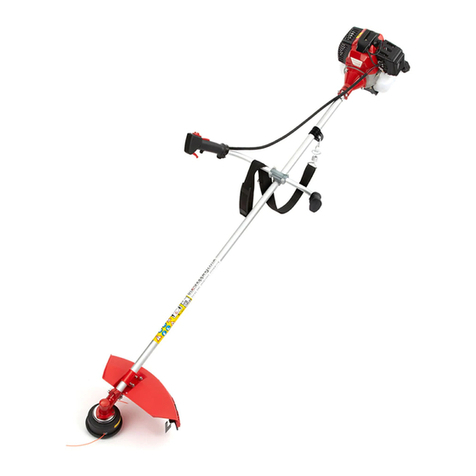
Trueshopping
Trueshopping BC2602D Installation and operating instructions
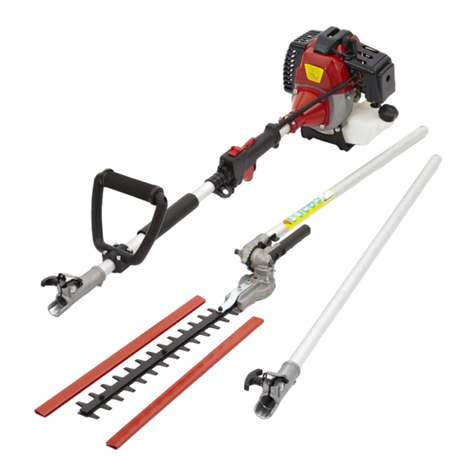
Trueshopping
Trueshopping MFS260HT Installation and operating instructions

Trueshopping
Trueshopping BC260A User manual
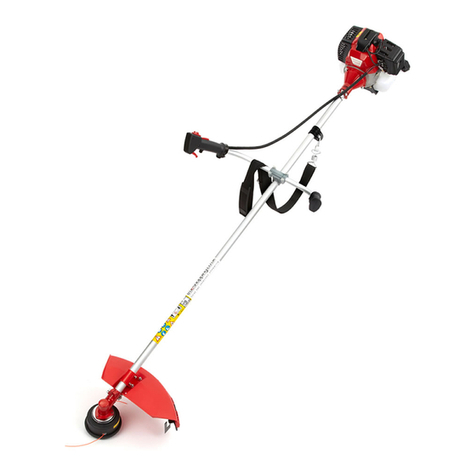
Trueshopping
Trueshopping BC1E34F User manual

